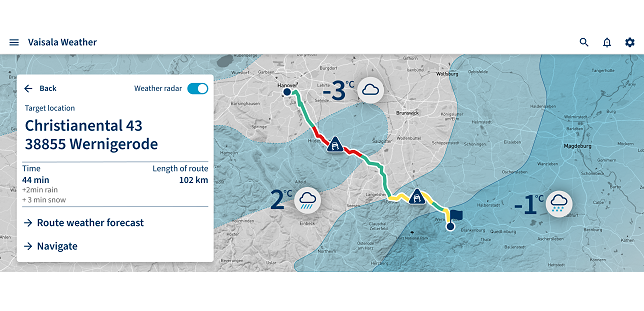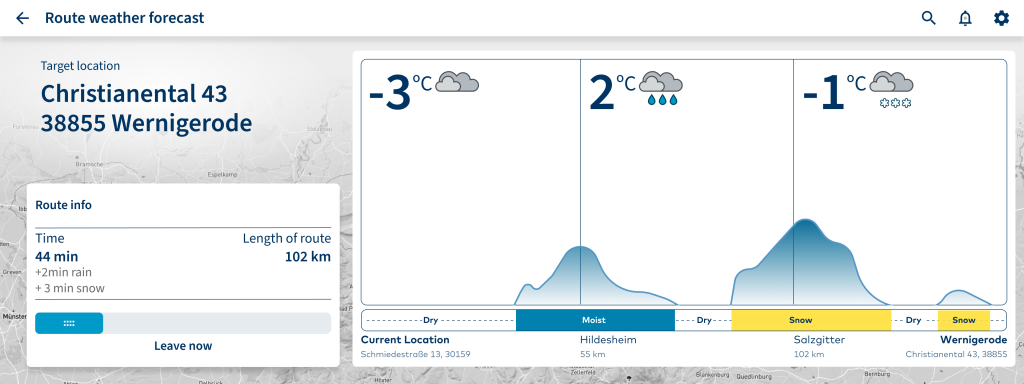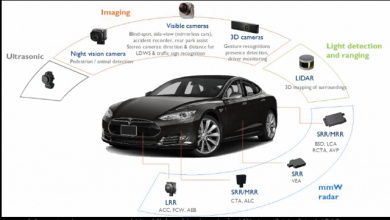Road Weather Data: Increasing the Safety of Today’s Drivers and Tomorrow’s Automated Vehicles

A combined cost related to automotive accidents in 2020 totaled an estimated $474 billion according to the Insurance Information Institute. When you consider the financial consequences, these numbers are staggering. Driver error and inclement weather are two of the primary factors in the number of incidents that happen on our roads. Fortunately, there are important innovations perused here, take these challenges head on.
Addressing Human Error on the Road
When it comes to driver error, the road safety ecosystem is changing thanks to the development and integration of new generations of advanced driver assistance systems (ADAS) and automated driving (AD) systems. As these technologies advance, society inches ever closer to the lofty promise of self-driving cars whisking us from point A to point B while we sleep, work or entertain ourselves.
Autonomous vehicles are tomorrow’s answers to no more car crashes, no more drunk driving and no more traffic once we hand over control of the steering wheel. While seat belts and air bags can reduce the number of deaths, new autonomous vehicle technologies could help even more as driver error is eliminated. In fact, research from the U.S. Department of Transportation found that fully autonomous vehicles could reduce traffic fatalities by up to 94% by eliminating accidents that are due to human error. With nine of 10 serious crashes occurring as a result of human behavior, automated vehicle technologies have the potential to save thousands of lives, as well as reduce congestion, enhance mobility and improve productivity.
While full autonomy for vehicles is currently out of reach, except in special trial programs, they will come to fruition in the future. This why automotive manufacturers, transportation authorities, insurance companies and other players in the road safety ecosystem are now preparing for the enormous impact that data-driven, data-deriving self-driving cars will ultimately have on society.
Then there is the issue of inclement weather. Weather is a component that impacts not only the future of autonomous vehicles, but today’s driver safety needs. The entire road safety ecosystem is taking the necessary steps now to know and take action to address inclement weather conditions on our roadways.
The Impact of Weather on Driver and Road Safety
Whether through visibility impairments, precipitation and accumulation, high winds, or extreme temperatures, weather events affect driver and passenger safety, vehicle performance, road friction, transportation infrastructure, traffic flow (or the lack thereof), and transportation agency operational decisions.
There are, on average, nearly 6 million vehicle crashes in the U.S. each year, and more than one in five of those accidents are weather-related. The Federal Highway Administration defines “weather-related crashes” as those that occur in adverse weather (i.e., rain, sleet, snow, fog, severe crosswinds or blowing snow/sand/debris) or on slick pavement (i.e., wet pavement, snowy/slushy pavement or icy pavement). Accordingly, with an average of nearly 6,000 people being killed, more than 440,000 people being injured and weather-related crashes costing $53 billion each year, inclement weather conditions clearly have a significant impact on roadways and traveling conditions, causing entirely too many accidents and too much damage.
Despite the promise of improved safety through the reduction of human error, automated vehicles too require highly accurate data about all types of road weather and surface conditions that — if not considered — can compromise the safety of ADAS and AD systems or initiate a system disconnect in adverse weather conditions.
While human drivers often make adjustments before and during their trips based on perceived weather and weather forecasts, they rarely cancel their journey because of the weather and often opt to just drive slower instead. However, the statistics starkly exhibit that this tactic is not a surefire way to ensure safety from the impact of weather.
So, how can both human drivers and autonomous vehicles mitigate weather-related risks? With greater situational awareness of the current weather conditions and improved road forecasting. Through a combination of today’s connected car capabilities and hyperlocal and timely weather and road weather predictions, promising opportunities to improve safety, efficiency and convenience for everyone on the road are emerging.
How Road Weather Data Can Mitigate Risk
Before a human driver or an autonomous vehicle can take action or even plan to take action, knowledge of what is happening on the roads is necessary. The decision-making process is based on accurate and reliable measurements of atmospheric and road weather conditions, and without such information, driver, passenger and road infrastructure safety remains in jeopardy.
Today, the optimal way to keep all drivers — from humans to self-driving cars — informed of weather and road weather conditions is by taking advantage of smart technology. The sensors and systems aboard connected vehicles gather massive amounts of information, such as real-time traffic, road incidents (e.g., accidents), and weather-related phenomena from wipers and braking systems, to keep drivers and driving systems informed, enabling them to anticipate how inclement weather could impact their trip.
By combining on-board sensors with cloud-based data processing and dynamic content, road weather technologies are able to collect the detailed atmospheric weather and driving condition forecasts necessary to inform drivers, ADASs and AD systems whether to adjust their travel schedule, take an alternate route or adjust driving behaviors to improve safety and convenience. With recent findings showing that ABS systems have been proven to reduce the number of accidents by 8% – imagine what a system connected to road conditions can make.
Leveraging Road Weather Technology
Despite its growing availability, very little data from connected vehicles is being used. Even in new model cars, drivers still receive very little support or real-time data pertaining to weather or driving conditions from in-vehicle technology — most drivers see just the ambient temperature reading in their car’s dashboard.
However, by providing precision road weather information in all conditions, road weather technology can help drivers, ADASs and ADs stay safe while conveniently optimizing route and travel times. Consequently, how can we make road weather technology more available and useful for drivers and stakeholders alike?
For starters, aligning the interests, capabilities and responsibilities of all stakeholders across the road safety ecosystem would be a positive first step. As automotive technology evolves, manufacturers must find ways to meet customer expectations for assisted and automated driving and in-car access to value-added infotainment content — while also supporting driver safety and passenger comfort.
Second, increasing communication between drivers and road authorities can help drivers adapt to environmental conditions while ensuring authorities responsible for road infrastructure safety have the information necessary to keep roads clear and safe. By leveraging road weather technology to increase communication between drivers, their vehicles and road authorities, drivers are better able to adjust how they drive to account for environmental conditions and road authorities can choose when and where to deploy fleets and the correct maintenance actions to take.

Finally, by providing road weather technology solutions to automotive manufacturers and suppliers, more players involved in the road safety ecosystem can begin using road weather technology to enhance driver safety and passenger comfort while providing valuable information to drive ongoing product development. Through a combination of automation and machine learning, new technologies are able to ingest measurements and forecasts and automatically convert that information into actionable insights.
Today, a significant amount of weather and road weather data comes from radars, mobile sensors, IoT sensors, road weather information systems and environmental sensor stations. This data can be used to deliver early warnings related to weather hazards like slippery roads, reduced visibility and strong winds, thereby enabling better route planning and notifying drivers to prepare and adjust for driving in poor conditions. In addition to hyperlocal atmospheric weather forecasts, modern road weather technologies are able to leverage data to predict current conditions ahead, factoring in different phenomena for slipperiness, poor visibility and other weather-related conditions affecting driving safety and traffic congestion.
Road Weather Technology in the Real World
As discussed, one way that road weather technology can improve driver/passenger safety is by informing drivers about hazardous road conditions. Whether through a vehicle’s digital infotainment system or by adapting a vehicle’s essential functions in real time, the weather-based navigation, dynamic routing and weather warnings advanced road weather technology provides can help both drivers and vehicle navigation systems.
Equipped with accurate and reliable road weather forecasts, drivers can respond by slowing down to avoid hazards and onboard vehicle systems can dynamically reroute toward safer and drier routes. Consider the following examples of how to use road weather technology improve safety.
Vaisala, a global leader in weather, environmental and industrial measurement, provides actionable road weather data and insights that can be used in various applications from infotainment to more sophisticated use cases. General weather condition information, detailed point forecasts, and road surface measurements and driving conditions forecasts combine to provide comprehensive information about external factors that can impact the driving experience. By delivering time-critical signals that can alert drivers, automated vehicles and in-car systems to safety issues as they happen – such as slippery roads, reduced visibility, strong winds, weather incidents, traffic or other road hazards – advanced data capabilities help drivers and vehicles make the necessary adjustments to minimize or eliminate the impact of poor conditions.
As the road safety ecosystem continues transitioning toward a driverless future, road weather technology will be essential in helping drivers stay safe while conveniently optimizing route and travel times as well as in developing and integrating ADASs and AD systems that depend on the technology’s ability to safely operate in environments where the conditions constantly change.
When it comes to road safety, better decisions can save lives. Because understanding the potential impact of weather on road networks is critical for maintaining safety and mobility, road weather technology solutions that leverage real-time weather observations and forecasts can both improve safety and support the ongoing research and development of advanced driving technology and customer-facing road weather products.
Author:

Timo Korpela
Head of Automotive and Partnerships
Vaisala
Timo Korpela leads Vaisala’s automotive partnerships and business development in North America. He has over 20 years of business management experience in telecommunications, wireless, human-machine interfaces, IoT and automotive. Based in Silicon Valley, Mr. Korpela has a unique perspective to automotive and road safety ecosystems that face their biggest disruption in 100 years with electrification, autonomy, software defined cars and spatial and weather aware vehicles
Published in Telematics Wire




